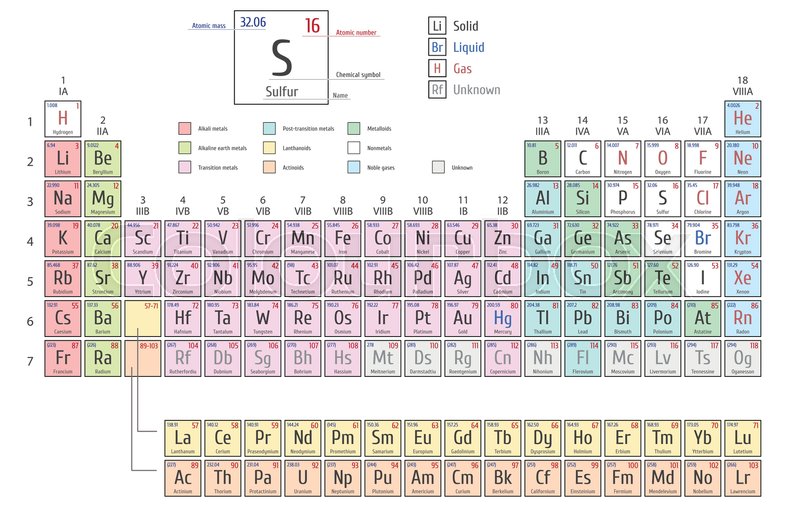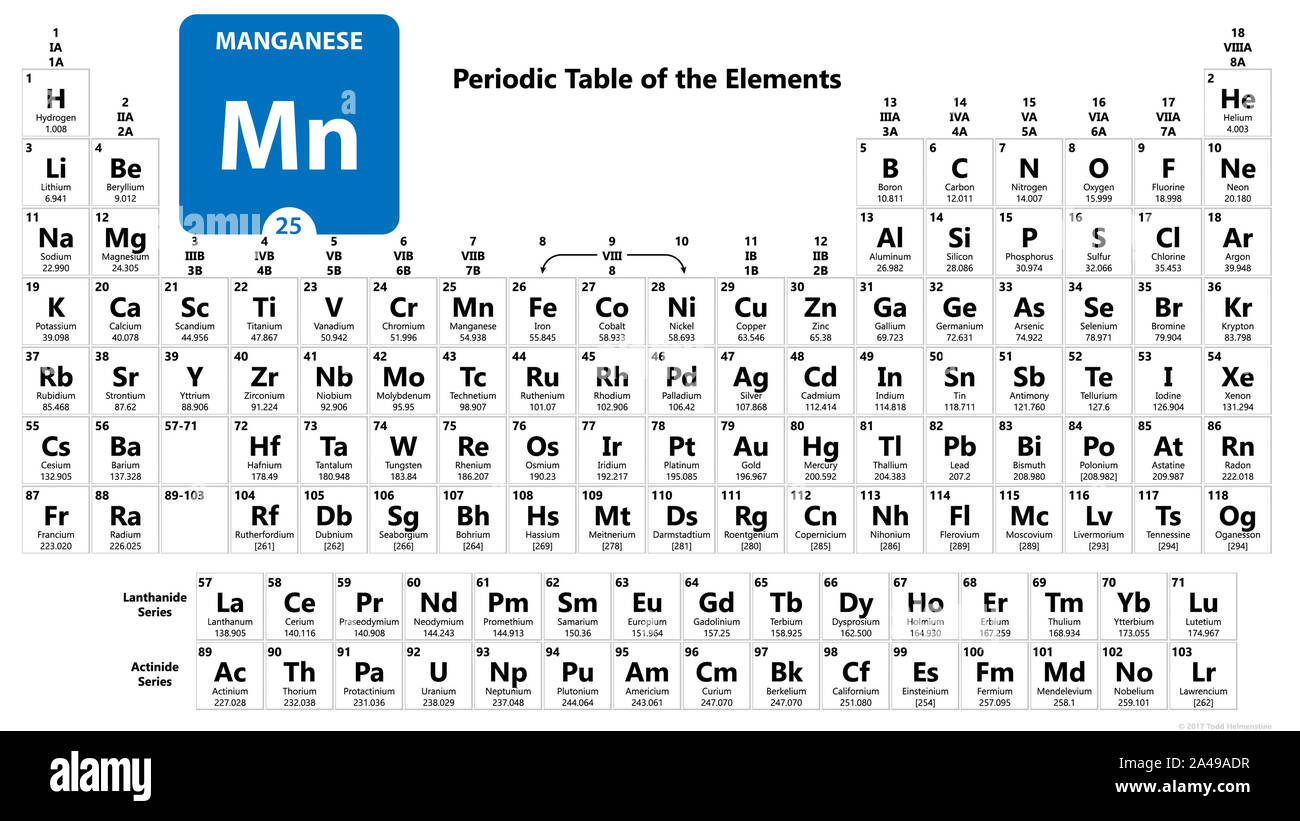- Gold Atomic Number
- Mn Atomic Mass
- Atomic Number For Mn Element
- Atomic Number For Mn
- Mn Atomic Number Electronic Configuration
The atomic mass of an element is the average mass of the atoms of an element measured in atomic mass unit (amu, also known as daltons, D). The atomic mass is a weighted average of all of the isotopes of that element, in which the mass of each isotope is multiplied by the abundance of that particular isotope. (Atomic mass is also referred to as atomic weight, but the term 'mass' is more accurate.)
For instance, it can be determined experimentally that neon consists of three isotopes: neon-20 (with 10 protons and 10 neutrons in its nucleus) with a mass of 19.992 amu and an abundance of 90.48%, neon-21 (with 10 protons and 11 neutrons) with a mass of 20.994 amu and an abundance of 0.27%, and neon-22 (with 10 protons and 12 neutrons) with a mass of 21.991 amu and an abundance of 9.25%. The average atomic mass of neon is thus:
| 0.9048 | × | 19.992 amu | = | 18.09 amu |
| 0.0027 | × | 20.994 amu | = | 0.057 amu |
| 0.0925 | × | 21.991 amu | = | 2.03 amu |
| 20.18 amu |
The atomic mass is useful in chemistry when it is paired with the mole concept: the atomic mass of an element, measured in amu, is the same as the mass in grams of one mole of an element. Thus, since the atomic mass of iron is 55.847 amu, one mole of iron atoms would weigh 55.847 grams. The same concept can be extended to ionic compounds and molecules. One formula unit of sodium chloride (NaCl) would weigh 58.44 amu (22.98977 amu for Na + 35.453 amu for Cl), so a mole of sodium chloride would weigh 58.44 grams. One molecule of water (H2O) would weigh 18.02 amu (2×1.00797 amu for H + 15.9994 amu for O), and a mole of water molecules would weigh 18.02 grams.
Construction waste doesn’t belong in the environment. That’s why recycling is such a top priority for Atomic. In fact, no other commercial construction and residential waste roll-off dumpster company in the Twin Cities, Minneapolis, St. Paul and surrounding areas can recycle more types or tons of debris than Atomic Recycling. This is a list of the 118 chemical elements which have been identified as of 2021. A chemical element, often simply called an element, is a species of atoms which all have the same number of protons in their atomic nuclei (i.e., the same atomic number, or Z). Manganese is a chemical element with the symbol Mn and atomic number 25. It is not found as a free element in nature; not verified in body it is often found in minerals in combination with iron. Manganese is a transition metal with a multifaceted array of industrial alloy uses, particularly in stainless steels. Atomic number of an element never changes: for example, the atomic number of oxygen is always 8, and the atomic number of Chlorine is always 18. The atomic number is marked with the symbol Z, taken from a German word zahl (or atomzahl, which is 'atomic number' in German). Choose from Mn Atomic Number stock illustrations from iStock. Find high-quality royalty-free vector images that you won't find anywhere else.
The original periodic table of the elements published by Dimitri Mendeleev in 1869 arranged the elements that were known at the time in order of increasing atomic weight, since this was prior to the discovery of the nucleus and the interior structure of the atom. The modern periodic table is arranged in order of increasing atomic number instead.
| The mineral rhodochrosite is a manganese carbonate. |
Manganese
| Atomic Number: | 25 | Atomic Radius: | 197 pm (Van der Waals) |
| Atomic Symbol: | Mn | Melting Point: | 1246 °C |
| Atomic Weight: | 54.94 | Boiling Point: | 2061 °C |
| Electron Configuration: | [Ar]4s23d5 | Oxidation States: | 7, 6, 5, 4, 3, 2, 1, −1, −2, −3 acidic, basic or amphoteric; depending on the oxidation state |
History


From the Latin word magnes, magnet, from magnetic properties of pyrolusite. Recognized by Carl Wilhelm Scheele, Torbern Olof Bergman, and others as an element and isolated by Gahn in 1774 by reduction of the dioxide with carbon.
Sources
Manganese minerals are widely distributed, with oxides, silicates, and carbonates being the most common. Large quantities of manganese nodules are found on the ocean floor and may become a source of manganese. These nodules contain about 24% manganese, together with many other elements in lesser abundance.
Most manganese today is obtained from ores found in Russia, Brazil, Australia, South Africa, Gabon, and India. Pyrolusite and rhodochrosite are among the most common manganese minerals. The metal is obtained by reduction of the oxide with sodium, magnesium, aluminum, or by electrolysis.
Gold Atomic Number
Properties

It is gray-white, resembling iron, but is harder and very brittle. The metal is reactive chemically and decomposes slowly in cold water. Manganese is used to form many important alloys. Manganese improves rolling and forging qualities in steel, along with adding strength, stiffness, wear resistance, hardness.
With aluminum and antimony, and especially with small amounts of copper, it forms highly ferromagnetic alloys.

Mn Atomic Mass
Manganese metal is ferromagnetic only after special treatment. The pure metal exists in four allotropic forms. The alpha form is stable at ordinary temperature; gamma manganese, which changes to alpha at ordinary temperatures, is said to be flexible, soft, easily cut, and capable of being bent.
Uses
The dioxide (pyrolusite) is used as a depolarizer in dry cells and is used to 'decolorize' glass that is colored green by impurities of iron. Manganese by itself colors glass an amethyst color and is responsible for the color of true amethyst. The dioxide is also used in the preparation of oxygen and chlorine and in drying black paints. The permanganate is a powerful oxidizing agent and is used in quantitative analysis and in medicine.
Atomic Number For Mn Element
Manganese is widely distributed throughout the animal kingdom. It is an important trace element and may be essential for utilization of vitamin B1.
Atomic Number For Mn
Handling
Mn Atomic Number Electronic Configuration
Exposure to manganese dusts, fume, and compounds should not exceed the ceiling value of 5 mg/m3 for even short periods because of the element's toxicity level.




